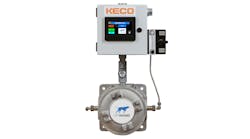This Control Talk column appeared in the September 2019 print edition of Control. To read more Control Talk columns click here or read the Control Talk blog here.
Greg: For aerobic biological processes, dissolved carbon dioxide (DCO2) is an essential process variable to understand what's happening upstream during a fermentation, bioreaction or a cell culture process. Far less recognized is that for nearly every pH system, the great disparity between theoretical and actual titration curves is due to what would be considered incredibly small amounts of DCO2 from simple exposure to air, and a corresponding amount of carbonic acid.
During upstream operations, an accumulation of too much dissolved CO2 can lead poor cell health, slower growth rate and increased death cell rate. Our bodies depend on our ability to inhale CO2 in the atmosphere at a concentration of about 0.04% by volume, maintain in-vivo a concentration of 5%, and exhale unwanted CO2. This is almost similar for mammalian cells, cultured ex-vivo using CO2 incubators and bioreactors. All new biological pharmaceuticals (biologics) produced since the early 1980s manipulate the addition of CO2 for pH control to change the concentration of carbonic acid. For most of the batch, the feed of CO2 neutralizes the weak bases (e.g., ammonia) formed during the metabolic process of living and particularly growing cells. DCO2 measurement is the key to monitoring and analyzing nearly all aerobic bioprocesses.
We can readily and reliably measure DCO2 online by simply inserting an electrode into the process. To help us understand the important considerations for a successful DCO2 measurement application, we have enlisted the help of Olivier Berteau (expert in Process Analytics Technologies at Mettler-Toledo) and included parts of the section on DCO2 measurement from Process/Industrial Instruments and Controls Handbook Sixth Edition 2019. This handbook has a chapter on advancements in analytical measurements for biological and chemical processes.
Olivier, what is the basic principle of operation?
Olivier: The DCO2 principle of measurement is called Severinghaus, developed by Dr. John W. Severinghaus and his technician A. Freeman Bradley in 1958. It uses a CO2-sensitive glass electrode in a surrounding bicarbonate buffer able to capture dissolved CO2 through a CO2-permeable silicon membrane. Basically, it’s a selective pH measurement of CO2 based on CO2 content in culture media passing through the silicone membrane of a CO2 sensor reacting with a specific electrolyte. A built-in temperature sensor is used to provide accurate temperature compensation. The same principle of measurement is used offline when sending a sample to a Blood Gas Analyzer (BGA) by scientists running cell culture. This is the reason why this CO2 sensor is widely used upstream for research and development, process design and manufacturing operation.
Greg: What are some key applications?
Here are the titles of resources offered by Olivier:
| 1. “Investigation of the interactions of critical scale-up parameters (pH, pO2 and pCO2) on CHO batch performance and critical quality attributes” | 2. “Selected Amino Acids Protect Hybridoma and CHO Cells from Elevated Carbon Dioxide and Osmolality” |
| 3. “The impact of pH inhomogeneity on CHO cell physiology and fed-batch process” performance – two-compartment scale-down modelling and intracellular pH excursion | 4. “Decreased pCO2 accumulation by eliminating bicarbonate addition to high cell‐density cultures” |
| 5. “Culture scale-up studies as seen from the viewpoint of oxygen supply and dissolved carbon dioxide stripping” | 6. “Measurement and Control of Dissolved Carbon Dioxide in Mammalian Cell Culture Processes Using an in Situ Fiber Optic Chemical Sensor” |
| 7. “A semi-empirical mathematical model useful for describing the relationship between carbon dioxide, pH, lactate and base in a bicarbonate-buffered cell-culture process” | 8. “Influence of aeration–homogenization system in stirred tank bioreactors, dissolved oxygen concentration and pH control mode on BHK-21 cell growth and metabolism” |
| 9. Large-scale mammalian cell culture | 10. Feeding lactate for CHO cell culture processes: Impact on culture metabolism and performance |
| 11. Glycosylation of CHO-Derived Recombinant tPA Produced under Elevated pCO2 | 12. Protein response of insect cells to bioreactor environmental stresses |
| 13. Mass Transfer and Mixing Across the Scales in Animal Cell Culture | 14. Bioreactor Headspace Purging Reduces Dissolved Carbon Dioxide Accumulation in Insect Cell Cultures and Enhances Cell Growth |
| 15. Bicarbonate Concentration and Osmolality Are Key Determinants in the Inhibition of CHO Cell Polysialylation Under Elevated pCO2 or pH | 16. Investigation of the interactions of critical scale-up parameters (pH, pO2 and pCO2) on CHO batch performance and critical quality attributes |
| 17. CHO cell viability in CO2 saturated media | 18. Characterization of Hybridoma Cell Responses to Elevated pCO2 and Osmolality: Intracellular pH, Cell Size, Apoptosis, and Metabolism |
| 19. High-density mammalian cell cultures in stirred-tank bioreactor without external pH control | 20. Dissolved CO2 Determines the Productivity of a Recombinant Hemagglutinin Component of an Influenza Vaccine Produced by Insect Cells |
| 21. CO2 – intrinsic product, essential substrate, and regulatory trigger of microbial and mammalian production processes | 22. Energy Metabolism of Cells Used for Industrial Production |
| 23. Effects of CO2 and osmolality on hybridoma cells: growth, metabolism and monoclonal antibody production | 24. High pC02 and/or Osmolality Effects on the Growth and Recombinant tPA Production of CHO Cells |
| 25. Effects of Elevated Dissolved CO2 Levels on Batch and Continuous Cultures of Aspergillus niger A60: an Evaluation of Experimental Methods | 26. CO2 – intrinsic product, essential substrate, and regulatory trigger of microbial and mammalian production processes |
| 27. The control and measurement of CO2 during Fermentation | 28. Effects of CO2 Concentration during Growth on Fatty Acid Composition in Microalgae |
| 29. Enhance Vitamin B12 Production by Online CO2 Concentration Control Optimization in 120 m3 Fermentation | 30. Extractive Fed-Batch Ethanol Fermentation with CO2 Stripping in a Bubble Column Bioreactor: Experiment and Modeling |
| 31. The influence of dissolved CO concentration on the death kinetics of Saccharomyces cerevisiae | 32. Simultaneous production of 1,3-propanediol and n-butanol by Clostridium pasteurianum: In situ gas stripping and cellular metabolism |
Olivier: DCO2 is important in many different applications, from beverage carbonation to mammalian and insect cell and aerobic microbial cultivation. There is currently no inline potentiometric Severinghaus electrode available for very high DCO2 concentrations expected in carbonation applications. The Severinghaus CO2 sensor remains accurate at 0-30% DCO2 but loses accuracy when concentration is higher. The most common use of inline DCO2 monitoring is in upstream bioprocessing because in many cases, the DCO2 concentration is a critical measurement. The DCO2 concentration impacts fluxes of key metabolic pathways as well as extracellular and intracellular pH, ultimately influencing growth, productivity and product quality. While the major application is in cell culture with mammalian and insect cells, this sensor is also useful for microbial models when CO2 and its accumulation is an issue and must be monitored carefully. CO2 is commonly monitored and controlled, for example, with organic acid fermentation as citric acid to avoid forming byproducts that affect productivity.
Greg: What are some watch-outs as to things that can go wrong?
Olivier: The main possibilities for a sensor not performing occur when recommendations for calibration haven’t been followed as prescribed. We also recommend using fresh electrolyte and a new sensor membrane prior sterilization. Pressure of the bioreactor should be used to compensate to avoid measurement errors, especially the error generated by static pressure. For extended fed-batch and continuous processes (e.g., perfusion), it is recommended to make regular process verification based on the BGA measurement of a process sample.
Greg: What are some installation and maintenance suggestions?
Olivier: In both clinical and commercial phases, it is essential to respect rules of preventive maintenance explained in our Good Operating Procedures (GoP) Guide. The sensor inserted into process must have its tip pointed down at angle equal to or higher than 15° (e.g., Ingold DN25 port).
To visually check the DCO2 sensor, we recommend the following procedure:
- The connector contacts must be dry. Moisture, corrosion and dirt can lead to false readings.
- Check the cable for kinks, brittle areas or tears.
- Examine the membrane foil optically for signs of damage. The foil must be intact and clean. Dirty membranes should be wiped clean using a soft, moist tissue.
An undulated membrane has no influence on the performance, assuming the membrane is intact.
- The membrane body must be replaced if the sensor has a long response time, the reading is unstable or subject to excessive drift, the sensor cannot be calibrated with CO2 gas or the membrane shows signs of mechanical damage.
- Check the pH-sensitive glass for cracks. The diaphragm should show a white color. If necessary, rinse with deionized water. Do not wipe dry the electrode even with soft paper because this can lead to an unstable signal during the process due to electrostatic charges.
Greg: What are the suggested frequency and methods for calibration?
Olivier: Calibration is achieved one time prior to sterilization, and process verification frequency depends on the process, typically based on the observed drift. Accuracy is considered good when CO2 between O-20% is within +/-1%, like the performance of a BGA offline.
For calibration, we highly recommend a BGA when possible, or using a method in a gas phase (small bioreactors less than 15 liters). For gas calibration at higher volumes, a specific housing is used (e.g., InTrac 797).
When pH calibration is the preferred method, the pH sensor is rinsed in pH 7 buffer, placed in fresh buffer 7 for calibration, rinsed in pH 9 buffer, placed in in fresh buffer 9 for calibration, rinsed in CO2 electrolyte, and finally placed in fresh electrolyte with a new membrane prior to sterilization.
The following best practices are offered:
- Ensure the inner pH electrode was stored wet in CO2 electrolyte.
- If bubbles are observed in the inner pH electrode, attempt to remove them by gently shaking the sensor.
- Perform a two-point calibration of the inner pH electrode with the pH buffer values specified by the manufacturer, without drying the inner pH electrode. Digital sensors typically arrive from the manufacturer pre-calibrated.
- Once the calibration values meet the manufacturer's specification, fill the CO2-permeable membrane with fresh CO2 electrolyte, then submerge the inner pH electrode within the CO2 electrolyte.
- Once the CO2 sensor is assembled, install it into the vessel. Ensure to maintain at least a 15° angle with the horizon.
- Perform a process calibration. This can be achieved with an offline sample or with a known CO2 concentration.
- When the process has ended, the CO2-permeable membrane can be discarded and the inner pH electrode should be stored with CO2 electrolyte in a non-permeable cap.
Greg: Some parting words of wisdom are to recognize the great value of DCO2 for better data analysis to diagnose bad batches and track down the possible causes. Data analytics depend on extensive and accurate measurements. For plant production of biologics, a bad batch often means a loss of $10 million or more and 10 or more days of production. A focus on the cost of additional electrodes is a bad joke. Electrode cost is also negligible for other bioreactors and fermenters with less-value-added products. It is critical that vessels have extra connections to facilitate the future addition of sensors.
10. Your temperature controller output is constant throughout the batch
9. Your dissolved-oxygen (DO) controller output is constant during the batch
8. Your pH controller output is constant throughout the batch
7. You pH controller is adding mostly a base throughout the batch
6. The operator has a favorite pH electrode that is consequently selected
5. No one knows when the electrodes’ calibrations were last checked
4. DO and pH controllers are not in automatic because an operator or process engineer wants to set flows
3. Industrial Internet of Things is the total solution
2. Emphasis is on project cost instead of better process measurement, analysis and automation
1. When asked how the batch going, the operator says, “Your guess is as good as mine.”







